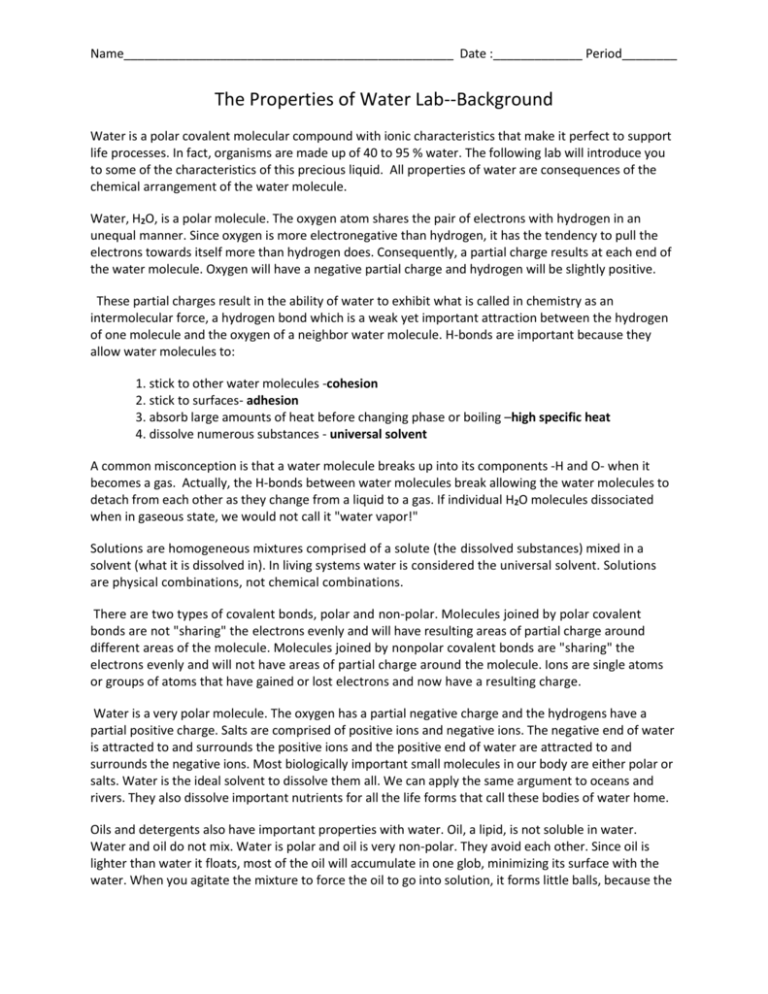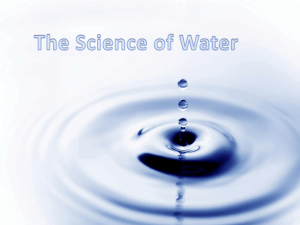the_properties_of_water_lab_background
advertisement

Name________________________________________________ Date :_____________ Period________ The Properties of Water Lab--Background Water is a polar covalent molecular compound with ionic characteristics that make it perfect to support life processes. In fact, organisms are made up of 40 to 95 % water. The following lab will introduce you to some of the characteristics of this precious liquid. All properties of water are consequences of the chemical arrangement of the water molecule. Water, H2O, is a polar molecule. The oxygen atom shares the pair of electrons with hydrogen in an unequal manner. Since oxygen is more electronegative than hydrogen, it has the tendency to pull the electrons towards itself more than hydrogen does. Consequently, a partial charge results at each end of the water molecule. Oxygen will have a negative partial charge and hydrogen will be slightly positive. These partial charges result in the ability of water to exhibit what is called in chemistry as an intermolecular force, a hydrogen bond which is a weak yet important attraction between the hydrogen of one molecule and the oxygen of a neighbor water molecule. H-bonds are important because they allow water molecules to: 1. stick to other water molecules -cohesion 2. stick to surfaces- adhesion 3. absorb large amounts of heat before changing phase or boiling –high specific heat 4. dissolve numerous substances - universal solvent A common misconception is that a water molecule breaks up into its components -H and O- when it becomes a gas. Actually, the H-bonds between water molecules break allowing the water molecules to detach from each other as they change from a liquid to a gas. If individual H2O molecules dissociated when in gaseous state, we would not call it "water vapor!" Solutions are homogeneous mixtures comprised of a solute (the dissolved substances) mixed in a solvent (what it is dissolved in). In living systems water is considered the universal solvent. Solutions are physical combinations, not chemical combinations. There are two types of covalent bonds, polar and non-polar. Molecules joined by polar covalent bonds are not "sharing" the electrons evenly and will have resulting areas of partial charge around different areas of the molecule. Molecules joined by nonpolar covalent bonds are "sharing" the electrons evenly and will not have areas of partial charge around the molecule. Ions are single atoms or groups of atoms that have gained or lost electrons and now have a resulting charge. Water is a very polar molecule. The oxygen has a partial negative charge and the hydrogens have a partial positive charge. Salts are comprised of positive ions and negative ions. The negative end of water is attracted to and surrounds the positive ions and the positive end of water are attracted to and surrounds the negative ions. Most biologically important small molecules in our body are either polar or salts. Water is the ideal solvent to dissolve them all. We can apply the same argument to oceans and rivers. They also dissolve important nutrients for all the life forms that call these bodies of water home. Oils and detergents also have important properties with water. Oil, a lipid, is not soluble in water. Water and oil do not mix. Water is polar and oil is very non-polar. They avoid each other. Since oil is lighter than water it floats, most of the oil will accumulate in one glob, minimizing its surface with the water. When you agitate the mixture to force the oil to go into solution, it forms little balls, because the Name________________________________________________ spherical shape has the smallest surface area with water for any given volume. When the balls of water get very small, they can stay suspended in the water for longer, but will eventually float to the surface again and reform the glob. Detergents are molecules which have polar ends, usually charged, which love water and non-polar ends, which love grease. If you agitate an oil and detergent mixture, the non-polar end of the detergent becomes embedded in the grease ball (as like dissolves like) leaving all the polar ends of the detergent facing the water. Thus the small droplets of oil have become surrounded by the detergent. The surface of this new "fuzzy" grease ball is the polar ends of the detergent, which have an affinity for water and can stay suspended in it longer, and do not stick to the side of the bottle to avoid water, like the grease alone did. Water organizes detergent into soap bubbles. In the soap bubble, the detergent forms a water sandwich, with detergent as an outer and inner layer and water in the middle. Of course the polar ends of the detergent face the inner water layer and the non-polar ends of the detergent are on the outside. Water's chemical formula is H2O. Each of hydrogen atoms are "attached" to one side of the oxygen atom, resulting in a positive charge on the side of the water molecule where the hydrogen atoms are attached and a negative charge on the other side, where the oxygen atom is attached. This uneven distribution of charge is called polarity. Since opposite electrical charges attract, water molecules tend to attract each other, making water kind of "sticky." The side of the water molecule with the hydrogen atoms (positive charge) attracts the oxygen side (negative charge) of a different water molecule.. This property of water is known as cohesion. All these water molecules attracting each other mean they tend to clump together. This is why water drops are, in fact, drops! If it wasn't for some of Earth's forces, such as gravity, a drop of water would be ball shaped -- a perfect sphere. Water is called the "universal solvent" because it dissolves more substances than any other liquid. This means that wherever water goes, either through the ground or through our bodies, it takes along valuable chemicals, minerals, and nutrients. This property that allows water to stick to other polar surfaces, is known as adhesion. Water, the liquid commonly used for cleaning, has a property called surface tension. In a body of the water, each molecule is surrounded and attracted by other water molecules. However, at the surface, those molecules are surrounded by other water molecules only on the water side. A tension is created as the water molecules at the surface are pulled into the body of the water. This tension causes water to bead up on surfaces (glass, fabric), which slows wetting of the surface and inhibits the cleaning process. You can see surface tension at work by placing a drop of water onto a counter top. The drop will hold its shape and will not spread. In the cleaning process, surface tension must be reduced so water can spread and wet surfaces. Chemicals that are able to do this effectively are called surface active agents, or surfactants. They are said to make water "wetter." Surfactants perform other important functions in cleaning, such as loosening, emulsifying (dispersing in water) and holding soil in suspension until it can be rinsed away. Surfactants can also provide alkalinity, which is useful in removing acidic soils. Page 2 Tyndall








